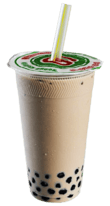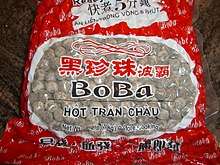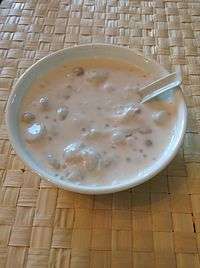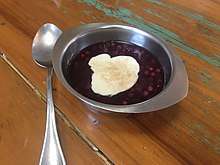Tapioca balls
Tapioca balls are translucent spheres produced from tapioca, a starch extracted from the cassava root.[1] They originated as a cheaper alternative to pearl sago in Southeast Asian cuisine.[2][3] They are most commonly referred to as boba (a transliteration of the word "bubble") or pearls when in bubble tea; these are typically five- to ten-millimeter starch balls, consisting of sweet potato powder, potato powder, or jelly. The various forms of tapioca balls include the original black, flavored, popping, mini, and clear.[4] By adding different ingredients, like water, sugar, and seasoning, tapioca balls can be made to vary in color and in texture. The most common, and original, tapioca balls are usually soaked in a simple sugar syrup to give it a little bit of sweetness while keeping it fresh.[5] They typically lack flavor and gel easily, and are therefore often used as a thickening agent in foods like pudding. The tapioca pearls are simply there to provide texture, the flavor really comes from the drink itself. [6]
.jpg)
History
Middle: Es campur, an Indonesian shaved ice dessert with various fruits and jellies;
Right: Sagu de vinho with crème anglaise, a southern Brazilian dessert of tapioca pearls in wine
Making jelly-like desserts from starch and using them in dessert dishes and drinks originated from Island Southeast Asia. The traditional versions of "pearls" are usually made from native starch sources like palm hearts or glutinous rice, they include pearl sago, landang, and kaong, among others. They are used in a wide variety of dishes and drinks like bilo-bilo, binignit, es campur, es doger, and halo-halo, among others. The introduction of cassava from South America during the colonial era added another starch source to Southeast Asian cuisine, resulting in cassava-based versions of traditional Southeast Asian dishes that were formerly made from native starch sources. Among these are tapioca pearls, which originated as a cheaper alternative to pearl sago. They are virtually indistinguishable in taste and can be used interchangeably.[2][3]
Pearl sago and tapioca pearls were introduced to Chinese cuisine via the Hokkien diaspora. They are popularly sold in "jelly tapioca pearls" (also known as "frog egg drinks") which are adaptations of Southeast Asian drinks and shaved ice desserts. They get their Mandarin name, “frog eggs,” from their white appearance in the center after cooking. Vendors who sell the drink usually add some syrup or creamer before serving, or serve it on top of shaved ice.[7] In Taiwan, it is more common for people to refer to bubble tea as pearl milk tea (zhēn zhū nǎi chá, 珍珠奶茶) because originally small 1/12” tapioca pearls were used. It was only when one tea shop owner—in an attempt to make his tea stand out—decided to use larger tapioca balls and chose a more provocative name, “boba,” to represent the difference. In Chinese, the word boba, 波霸, is a combination of a word for bubble and a word for big, which, when found together, is slang for “big breasts” or “buxom lady.” When used to describe the drink, the characters 波霸奶茶 directly translate to boba milk tea, and loosely to bubble milk tea. This translation is commonly used by English speakers and refers to the variant with 1/4" tapioca pearls.[8]
The making of tapioca balls were also introduced to Brazil (where cassava is native), where they are still known as sagu, despite being made from cassava and not sago palms.[9] It is used in a traditional dish known as sagu de vinho ("wine sago"), popular in the southern state of Rio Grande do Sul. It is usually mixed with sugar and red wine and then served generally warm.[10]
Popularity

Tapioca pearls has recently gained widespread popularity due to the spread of the Taiwanese bubble tea, also called boba tea, across Europe and Germany in particular, after already converting young people across North America. McDonald's restaurants in Germany have begun selling the dessert beverage as part of its revamped McCafé menu.[11]
Manufacturing
Tapioca pearls are derived as baked tapioca products, which are obtained from heat treatment of the moist cassava starch in shallow pans.
Preparation of wet flour
To create pearls, tapioca starch/flour is mixed with boiling water until a kneadable consistency is achieved. The dough is cut and rolled into a spherical shape. One method of achieving the correct shape is called the gangsor method. The starch is inserted into a long, cylindrical twill cloth bag and a jerking motion is used to toss the starch lumps back and forth. The lumps will become more firm and gain a more spherical shape. The process is repeated until the pearls have roughly become the desired size. Afterwards, the pearls will be sorted according to size.
Another method is to feed the moist flour into open cylindrical pans, which rotate for a certain amount of time and at a specific speed to form the pearls.[12]
Gelatinization
Traditionally, during heat treatment, the temperature is kept moderate so that only the surface layer of the lumps of the moist starch begins to gelatinize, and this process is described as gelatinization. One process of gelatinization is performed by placing the pearls inside shallow pans, which are then placed inside a brick oven. The pans are covered with a towel soaked in oil or fat to prevent burning the starch. While the pearls are heated over a moderate fire, it is stirred continuously with large forks to prevent burning. When this hand-baking process is applied to manufacture pearls, irregularly shaped beads may be obtained, inferior in colour and in other qualities.
In order to produce first-rate products, the starch beads are poured onto plates in a thick layer, and the plates are slowly drawn through a tunnel charged with steam. In this way, uniform gelatinization are ensured.[12]
Drying
During the gelatinization process, the moisture content does not change very much so another drying stage is required to achieve the desired moisture content of 12%. Drying is done in a chamber drier and when drying, it must have an initial temperature of below 40 °C to avoid further gelatinization.[12]
Freezing
Other than drying, freezing could also be used to preserve pearls before consumption. After gelatinization, the pearls are soaked in ice water to decrease the viscosity and enhance its chewiness. Afterwards, it should be frozen using a quick freezing device, such as an air-blast freezer, or through an individual quick freezing process to avoid pearls from sticking together. [13] One important note is that retrogradation happens quickest at near 0 °C temperatures, which would lead to tougher pearls, so it is best to minimize the time that the pearls spend in that temperature range and freeze the pearls to lower temperatures quickly. [14]
Preparation for consumption

Consumers and food retail establishments can purchase raw tapioca starch and create their own pearls, or they can purchase partially cooked pearls, which have already gone through the gelatinization process. Raw tapioca pearls usually require 45 minutes of boiling whereas partially-cooked tapioca pearls require 30 minutes. To ensure chewy texture, the pearls are then cooled for approximately 20 minutes. One can verify whether the pearls are ready to serve is by taking a pearl and chewing it, making sure it is well-cooked all the way to the center.
In addition to the shorter cooking time, another benefit of partially cooked tapioca is that it lasts longer, with a shelf life of 8 months compared with the shelf life of 6 months for raw tapioca. Cooked tapioca pearls should only be kept for around 4-6 hours. When serving tapioca pearls, the pearls will harden once it is submerged in water and will eventually soften and lump together. Lumping of tapioca pearls can be avoided by stirring and adding sugar.[15]
After the tapioca pearls are cooked, they should be strained through a colander. After straining, they should be rinsed to remove excess starch. Then, if they're to be used as something sweet, such as in bubble tea or as a dessert topping, the tapioca pearls are soaked in a sugar solution for ten minutes. The sugar will also help to prevent them from lumping.[16] There is only one way to determine the quality of the tapioca pearls-the texture. The pearls will all stick together if they are too soft and squishy. The pearls will be too difficult to chew if the pearls are too hard. There is a balance for tapioca being both chewy and firm. There is a Chinese term for this pronounced "QQ". This is similar to the Italian term "Al dente" describing pasta that is chewable, but not too soft.[17]
Health and nutrition information
Tapioca consists of mostly carbohydrates-one cup contains nearly 550 calories and 135 grams of carbohydrates. Some benefits of tapioca are that it is a source of iron, dietary fiber, and manganese. In addition, tapioca is a good option for those that have allergies to gluten, nuts, or grain since it does not contain any of them. Tapioca also contains very little cholesterol, fat, or sodium.[18]
Additives
To support to the creation of tapioca pearls, some additives are used, especially during the tapioca flour making process.
- Sulfuric acid is added as a bleaching agent and helps to speed up the process of making flour.
- Aluminum sulfate is useful for increasing the viscosity of the flour.
- Sulfur dioxide is used to separate the starch from other unwanted substances as well as acting as a bleaching agent, and regulating microbial and enzymatic reactions.
- Chlorine helps to create a higher quality flour and also has disinfecting and bleaching properties.
The tables below list permitted additives in tapioca pearl products regulated under different regions.
Additives permitted as domestic or imported food
Philippines
| Categories | Additives |
|---|---|
| Flavor Enhancer, Sweetener |
Acesulfame Potassium, Phosphates |
| Antioxidant |
Ascorbyl Esters, Phosphates, BHA |
| Color |
Caramel Colors, Phosphates, Allura Red AC, Azorubine, Brilliant Black PN, Brilliant Blue FCF, Canthaxanthin, Carmines |
| Acidity Regulator, Firming Agent, Raising Agent |
Adipates, Phosphates |
| Preservative |
Benzoates |
Singapore
| Categories | Additives |
|---|---|
| Flavor Enhancer, Sweetener |
Acesulfame-K, Saccharin, Cyclamates (as cyclamic acid), Neotame, Sucralose |
Taiwan
| Categories | Additives |
|---|---|
| Starch Modifying Agents |
Sodium Trimetaphosphate, Azodicarbonamide, Benzoyl Peroxide, Sodium γ-Polyglutamate |
| Bleaching, Maturing and Dough Conditioning Agents |
Potassium Sulfite, Sodium Sulfite(Anhydrous), Sodium Bisulfite, Sodium Hydrosulfite, Potassium Metabisulfite, Potassium Bisulfite, Sodium Metabisulfite |
| Coloring Agents |
Caramel Colors |
| Categories | Additives |
|---|---|
| Antioxidants |
L-Ascorbic Acid (Vitamin C), Sodium L-Ascorbate, L-Ascorbyl Stearate, L-Ascorbyl Palmitate, Erythorbic Acid, Sodium Erythorbate, dl-α-Tocopherol( Vitamin E), Calcium L-Ascorbate, Mixed Tocopherols Concentrate, d-α-Tocopherol Concentrate |
| Leavening Agent |
Potassium Alum, Sodium Alum, Burnt Potassium Alum, Ammonium Alum, Burnt Ammonium Alum, Ammonium Chloride, Potassium Bitartrate, Sodium Bicarbonate, Ammonium Carbonate, Ammonium Bicarbonate, Potassium Carbonate, Baking Powder, Acidic Sodium Aluminum Phosphate, Burnt Sodium Alum |
| pH Adjusting Agents, Acid-Reacting Materials and Water Correcting Agents |
Calcium Chloride, Calcium Hydroxide, Calcium Sulfate, Calcium Gluconate, Calcium Citrate, Monobasic Calcium Phosphate, Dibasic Calcium Phosphate, Dibasic(Anhydrous) Calcium Phosphate, Tribasic Calcium Phosphate, Calcium Dihydrogen Pyrophosphate, Calcium Glycerophosphate, Calcium Lactate, Calcium Stearoyl Lactylate, Ammonium Carbonate, Potassium Carbonate, (Anhydrous) Sodium Carbonate, Magnesium Carbonate, Ammonium Sulfate, Sodium Sulfate, Magnesium Stearate, Magnesium Sulfate, Magnesium Chloride, Monobasic Ammonium Phosphate, Dibasic Ammonium Phosphate, Monobasic Potassium Phosphate, Dibasic Potassium Phosphate, Tribasic Potassium Phosphate, Monobasic Sodium Phosphate, Monobasic(Anhydrous) Sodium Phosphate, Dibasic Sodium Phosphate, Dibasic( Anhydrous) Sodium Phosphate, Tribasic Sodium Phosphate, Tribasic( Anhydrous) Sodium Phosphate, Potassium Metaphosphate, Sodium Metaphosphate, Potassium Polyphosphate, Sodium Polyphosphate, (Anhydrous) Sodium Acetate, Glycerol, Sodium Stearyl 2-Lactylate, Bentonite, Aluminum Silicate, Diatomaceous Earth, Talc, Sodium Silicoaluminate, Silicon Dioxide, Calcium Oxide, Potassium Bicarbonate, Stearic Acid, Adipic Acid, Aluminum Sulfate, Perlite, Sodium Stearate, Potassium Stearate, Hydroxypropyl Cellulose, Hydroxypropyl Methylcellulose( Propylene Glycol Ether of Methylcellulose),Polydextrose, Disodium Dihydrogen Pyrophosphate, Potassium Pyrophosphate, Sodium Pyrophosphate, Sodium Pyrophosphate (Anhydrous), Anhydrous Calcium Chloride, D-Sorbitol Solution 70%, D-Xylitol, D-Mannitol, Maltitol, Maltitol Syrup (Hydrogenated Glucose Syrup), Isomalt (Hydrogenated Palatinose), Lactitol, Erythritol |
| Nutrient Additives |
Triglyceryl Linoleate, L-HistidineMono-hydrochloride, L-Isoleucine, etc. |
| Coloring Agents |
Cochineal Red A (New Coccin), Erythrosine, Erythrosine Aluminum Lake, Tartrazine, Tartrazine Aluminum Lake, Sunset Yellow FCF, Sunset Yellow FCF Aluminum Lake, Fast Green FCF, Fast Green FCF Aluminum Lake, Brilliant Blue FCF, Brilliant Blue FCF Aluminum Lake, Indigo Carmine, Indigo Carmine Aluminum Lake, β-Carotene, β-Apo-8'-Carotena, Ethyl β-Apo-8'-Carotenoat, Canthaxanthin, Laccaic Acid, Sodium Iron Chlorophyllin, Iron Oxides, Allura Red AC, Titanium Dioxide, Allura Red AC Aluminum Lake, Synthetic Lycopene, Cochineal Red A Aluminum Lake( New Coccine Aluminum Lake) |
| Flavor Enhancer |
Ethyl Acetate, Butyl Acetate, Benzyl Acetate, Phenylethyl Acetate, Terpinyl Acetate, Cinnamyl Acetate, Geranyl Acetate, Citronellyl Acetate, Linalyl Acetate, Isoamyl Acetate, etc. |
| Sweetener |
D-Sorbitol, 70% D-SorbitolSolution, D-Xylitol, Glycyrrhizin, Trisodium Glycyrrhizinate, D-Mannitol, Aspartame, Licorice Extracts, etc. |
| Flavors |
MonosodiumL-Aspartate, Fumaric Acid, MonosodiumFumarate, Citric Acid, Sodium Citrate, Succinic Acid, MonosodiumSuccinate, Disodium Succinate, L-Glutamic Acid, MonosodiumL-Glutamate, etc. |
| Emulsifying, Gelling, Stabilizing and Thickening Agents |
Casein, Sodium Caseinate, Calcium Caseinate, Sodium Carboxymethyl Cellulose, Calcium Carboxymethyl Cellulose, Acid-Modified Starch, Methyl Cellulose, Sodium Polyacrylate, Carrageenan, Xanthan Gum, Alginic Acid, etc. |
Environmental issues
Tapioca is not a natural product, as it is processed from cassava. See Manufacturing. There is an issue with tapioca because a large amount of water is needed in order to produce it. One factory reports that it uses around 60 m3 for one ton of tapioca starch just in the first step of processing. With this much water being used, properly disposing of the wastewater is a priority. Tapioca contains cyanide, and depending on whether or not the tapioca is made for human consumption or industrial purposes there will be less or more cyanide. The wastewater used to process the tapioca contains this cyanide and if the wastewater is leaked into bodies of water containing aquatic life, due to the contaminated water's low pH, there is a direct effect on fish and possibly other animals that live on the shores of the polluted water. Water pollution from tapioca manufacturing has been a problem in many countries in Southeast Asia.[21]
Controversy
German researchers from University Hospital Aachen tested the tapioca pearls from an unnamed Taiwanese chain. According to the Daily News, the report showed that carcinogenic chemicals were found in the samples. Chemicals found included styrene, acetophenone, and brominated substances, which were not permitted as food additives.[22] Another German study found carcinogenic PCBs, or polychlorinated biphenyls, in the starchy balls as well.[23]
But the German reports didn’t specify the amount of substances they found in the tapioca pearls, and were not published in peer-reviewed medical or scientific journals. That is saying the accuracy of the results are not ensured.[24]
Phthalates are a class of chemicals added to plastics for the purpose of strengthening plastic’s flexibility, durability, longevity and transparency. In 2011, the Canadian Food Inspection Agency warned of phthalate contamination in some food items imported from Taiwan.[25] DEHP, a type of phthalates, was reportedly found in concentrated juice beverages, tea drinks, and other food supplements. This low cost substance had replaced regular food additives, which would normally be an emulsifier for the contents inside the drinks to generate a more attractive and natural appearance. Over-consumption of phthalates can lead to very serious negative health effects such as endocrine disruption, malformation of reproductive organs, infertility and abnormal neurodevelopment. The tolerable daily intake of DEHP is 0.05 mg/kg/day for a 70 kg body weight individual.[26] Fortunately, the study showed that some beverages contain phthalates at levels that do not exceed the daily limit.[27] In high concentrations, it could modify the product's appearance significantly as well.[28]
In 2013, the Agri-Food and Veterinary Authority of Singapore recalled tapioca balls from bubble tea shops after 11 kinds of Taiwanese starch additives that contained maleic acid were discovered.[29] Maleic acid, when ingested, is known to induce kidney damage. An experiment done on dogs and rats also found kidney and liver damage when they were given daily doses of maleic acid for two years. [30]
In June 2019, there was a case where a 14 year old girl from China was admitted to the hospital after she described her stomach pain and constipation. After Dr. Zhang Louzhen, from the Zhuji People's Hospital, gave her a CT scan, he saw over one hundred small, grey spheres sitting in parts of her abdomen.[31] The starch that tapioca balls are made of, in combination of thickeners and other additives, when consumed in large amounts may lead to bowel obstruction. [32]
See also
References
- Editor, Julie R. Thomson Senior; Taste; Post, The Huffington (2015-07-13). "So What Exactly Is Tapioca, Anyway?". The Huffington Post. Retrieved 2016-11-18.CS1 maint: extra text: authors list (link)
- Hutton, Wendy (2012). Southeast Asia's Best Recipes: From Bangkok to Bali. Tuttle Publishing. ISBN 9781462905683.
- Alford, Jeffrey; Duguid, Naomi (2000). Hot Sour Salty Sweet: A Culinary Journey Through Southeast Asia. Artisan Books. p. 323. ISBN 9781579655648.
- "The 5 Most Common Types of Boba, Explained for the Bubble Tea Newbie". Spoon University. 2018-04-11. Retrieved 2020-03-11.
- Hughes, Becky. "DIY Bubble Tea Is About to Be Your New Summer Go-To". Epicurious. Retrieved 2020-03-11.
- "So what is bubble tea, exactly? Everything you need to know about the drink and boba balls". Mic. Retrieved 2020-03-11.
- "Taiwan Night Market Snacks". dfll.nchu.edu.tw. Retrieved 2016-11-18.
- "Bubble Tea: 25 Things You Didn't Know | Eat This Not That". Eat This Not That. 2016-02-05. Retrieved 2016-11-18.
- "Curiosidades sobre o Sagu com Creme". Galeto di Paolo. 2018-07-27. Retrieved 24 July 2019.
- "Sagu de vinho tinto (Tapioca Pearls in Red Wine)". Sabor Brasil. Retrieved 28 June 2019.
- Bennett-Smith, Meredith (2012-09-05). "Bubble Tea Tapioca Pearls May Cause Cancer, Study Says". The Huffington Post. Retrieved 2016-11-18.
- "Cassava processing - Cassava flour and starch, Baked tapioca products, Cassava products for animal feeding, Cassava starch factories". www.fao.org.
- US application 20140335244, Shih-Ting Chen & Chin-Hua Chiang, "Frozen instant tapioca pearls and method for manufacturing the same", published 2014-11-13, assigned to Fong Chen Frozen Food Co., Ltd.
- US grant 6455091, Patrick Po-Yung Ling & Janie Huoy-Jen Lai, "Time saving method for preparing tapioca starch balls and the product thereof", published 2002-09-24
- "The Nature of Tapioca Pearls". www.bruceandclark.com.
- "HOW TO COOK TAPIOCA PEARLS -- PROFESSIONAL GUIDE". www.restaurantsupplydrop.com.
- "A Brief History of Boba". Food & Wine. Retrieved 2019-06-28.
- "11 healthy nutrition facts about tapioca". Medical News Today. Retrieved 2019-06-26.
- 林詠萱; 王素梅. "飲冰品原料外銷法規研析Study on Food Import Regulation of Drink Ingredients in Philippines, Singapore and Australia" (PDF). 臺北市食材登錄平台. 台北市政府衛生局.
- "附表一食品添加物使用範圍及限量" (PDF). 食品藥物消費者知識服務網.
- Bengtsson, Bengt-Erik; Triet, Tran (December 1994). "Tapioca-Starch Wastewater Toxicity Characterized by Mircrotox and Duckweed Tests". Ambio. 23 (8): 473–477. JSTOR 4314263.
- "Bubble Tea Tapioca Pearls May Cause Cancer, Study Says". HuffPost Canada. 5 September 2012.
- "Bubble tea can contain carcinogens, researchers claim". CTVNews. 6 September 2012.
- "Be Well: Tapioca Pearl Problems". @berkeleywellness.
- "Canada Warns of Juice Imports with Phthalates". Food Safety News. 2011-05-31. Retrieved 2019-06-15.
- "Phthalates: 5. What daily exposure levels to phthalates are considered safe?". ec.europa.eu. Retrieved 2019-06-15.
- "Phthalates: 5. What daily exposure levels to phthalates are considered safe?". ec.europa.eu. Retrieved 2019-06-23.
- Truong, Nicole; Karakilic, Vanessa; Soulsbury, Kevin. "Detection of DEHP in beverages sold in Canada using gas chromatography-mass spectrometry". Bcit Environmental Health Journal.
- migration (2013-05-28). "'Pearls' dropped by some bubble tea shops". The Straits Times. Retrieved 2019-06-24.
- "Maleic Acid". U.S National Library of Medicine.
- Castrodale, Jelisa; Pollack, Hilary (2019-06-11). "Girl's Abdominal Blockage Reportedly Caused by Hundreds of Undigested Boba Pearls". Vice. Retrieved 2019-06-26.
- Undigested Bubble Tea Pearls Are Actually Impacted Faeces


